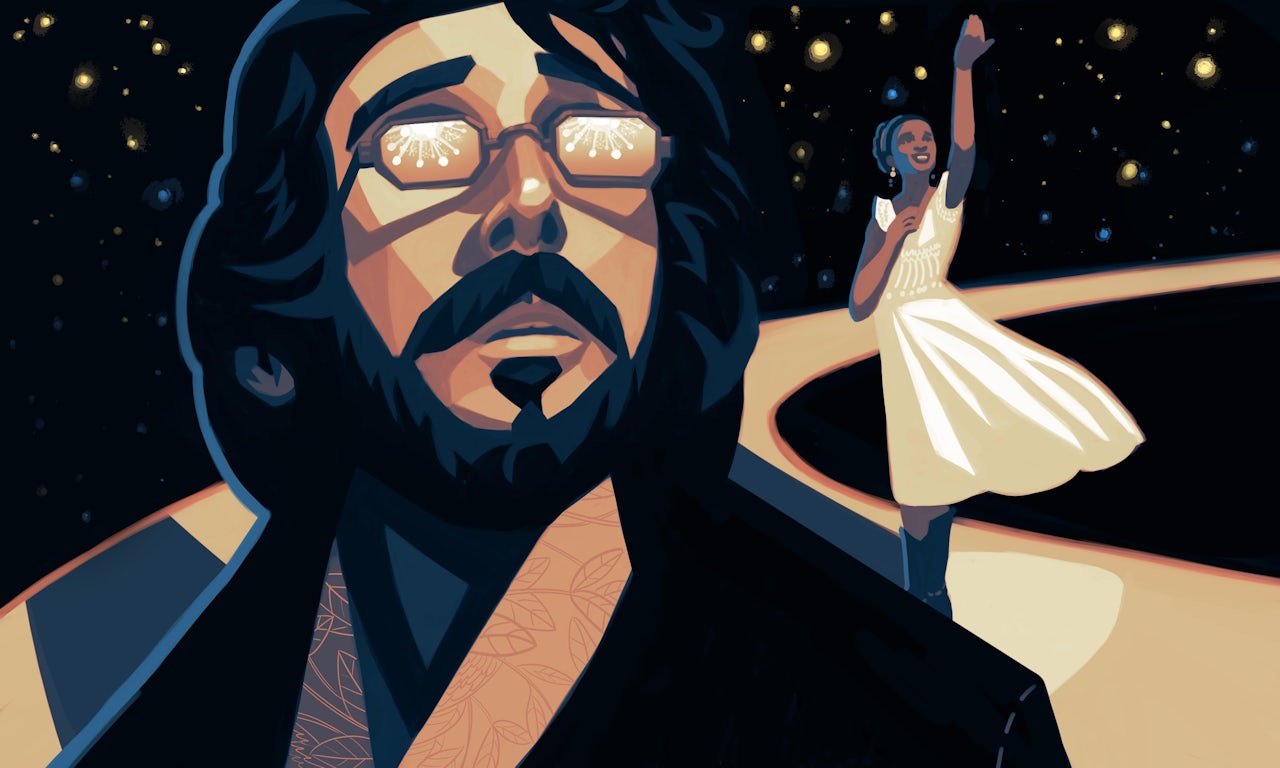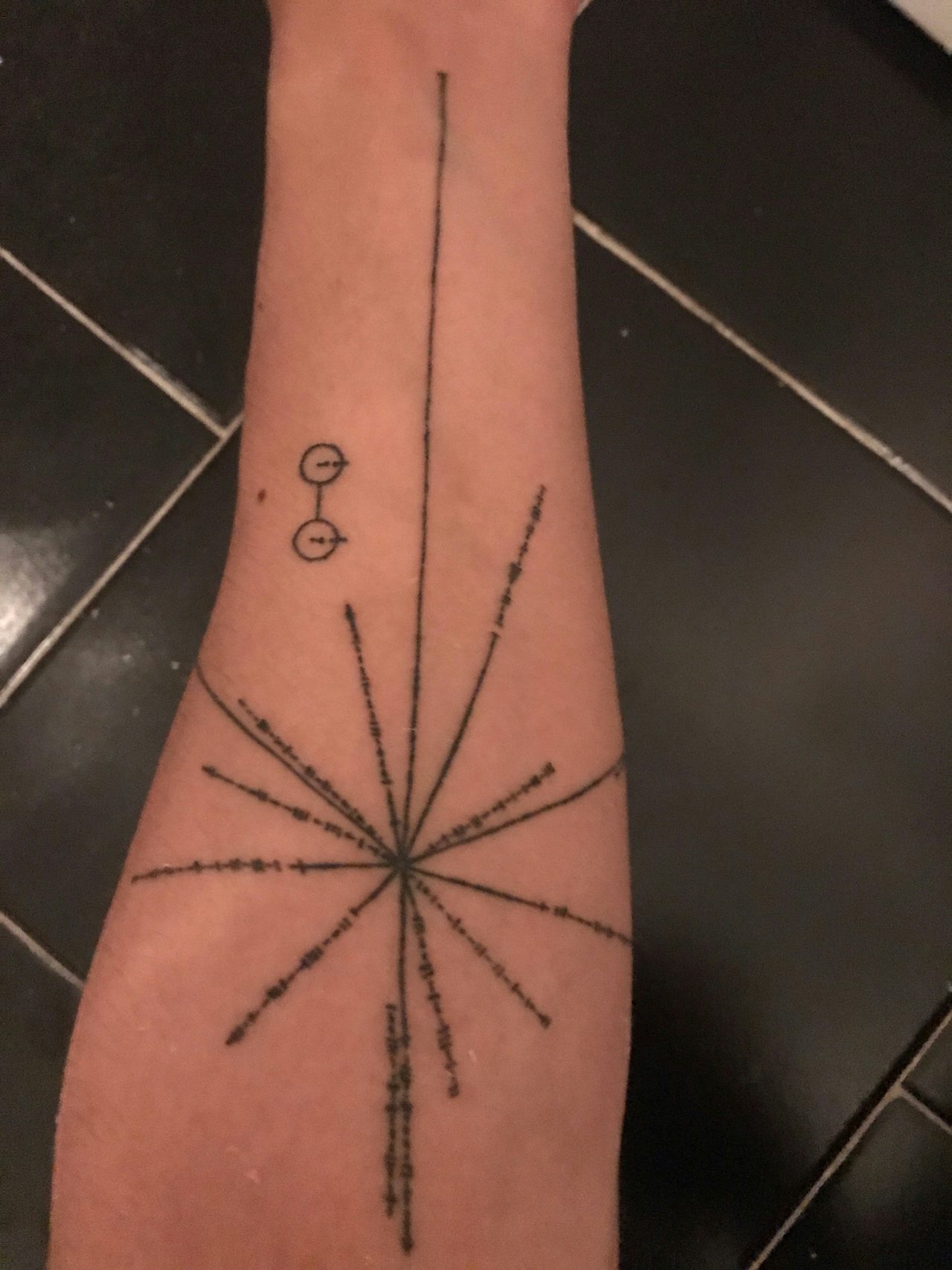This summer, two of my friends got beautiful tattoos. The images, though on people who didn’t know each other, seemed connected. They were confirmation that people in my life were drawn to the ethereal as a way to ground themselves. They also bore a striking resemblance.
“It’s a pulsar map,” one told me as he stretched his forearm and ran his fingers over the ink. The tattoo was a series of lines of varying lengths extending from a central point, like an artist’s rendering of a ray of light. In simple terms, the cosmic map was a depiction of the Earth’s location in relation to a series of pulsars — a class of neutron star. “It’s almost a way of telling myself, ‘I am here,’” he said.
Weeks later, another friend sent me a photo of a tattoo she got on her arm: A central point with lines and bulbs extending from it, like a postmodern chandelier. It reminded me of the pulsar map, but the reference was even more familiar to me: hers was an homage to the musical Natasha, Pierre & the Great Comet of 1812. After a 4-year journey in smaller theaters, it premiered on Broadway in November and will end its run on Sept. 3. It's quickly become my favorite musical and, as this stretch of its journey comes to an end, reminds me of the importance of art that navigates what it means to love, to struggle, and to declare your presence amid absolute chaos.
Comet, which is based on a section of Leo Tolstoy’s War and Peace, centers on Natasha, a Russian girl entering 19th-century Moscow society while her fiancé Andrey is fighting the French. “There’s a war going on / Out there somewhere / And Andrey isn’t here,” the cast sings in the first minutes of the musical. Her story runs parallel to that of the rich, depressed, and eccentric Pierre, who questions and frequently laments his existence. While out for a night at the opera, Natasha encounters the eerily sexy Anatole, and they are quickly infatuated with one another, which throws her life into disarray.
We broke down some musical moments from The Great Comet on our daily podcast, The Outline World Dispatch. Subscribe on Apple Podcasts or wherever you listen.
When the show closes — a result of backlash over a poorly handled casting controversy and lagging ticket sales — I’ll have seen it six times. That’s more than any play, musical, exhibit, concert, or other piece of live art I’ve experienced in my life, but still pales in comparison to some of the show’s superfans, and for a good reason.
Comet was a unique work that begged to be revisited, digested, seen from new vantage points, and absorbed by the soul. Mimi Lien's winding, interactive set design transformed the theater into a Russian supper club complete with small tables, on-stage seating, and elevated platforms. The set alone lent itself to infinite windows of entry and became a familiar home to me.
Musically, the score dips in and out of genre influences ranging from classical to techno, and is heard just as much as it is physically felt in the space. Clarinets and oboes hum along with actors, and synthesizers screech to the beat of strobe lights. As Anatole seduces Natasha, music director Or Matias traces each of his notes with a sensual, mirrored piano line. Those sounds became echos in my mind. Paloma Young's costumes reflect that controlled chaos, too — a mix of regal 19th century dresses and uniforms, and the tattered glam-grunge attire of a 1980s garage rock band. (One night, I saw a woman in total awe lean in at the edge of her seat to examine the embroidered details of an actor's denim jacket while he danced in the aisle.) The sum of these parts was a show that felt new every time I saw it, the minutiae of it so thrilling to discover. That ethos is rare and necessary as the pundits I see on TV get louder, online discourse veers into the inconsequential, and the time I have to hold onto anything worthwhile disappears faster than I can latch on.
This has been a year in which anything positive seems to be muffled or trampled immediately by a tweet from the president and the maelstrom each one introduces. Living a life mostly on the internet and on our devices creates an emotional tether to the incremental as a way of sustenance. As my colleague Leah Finnegan wrote recently, “instead of looking at aggregate events over time, we react to each bit of micro-news as if it is the worst thing that has ever happened.” What we choose as a means to untether ourselves without drifting away too much becomes crucial. For many people, including myself, the only things left to uplift must point in the direction of the skies as opposed to the Earth: a pulsar map as a reminder of known unknowns, a solar eclipse that portends change or salvation, or a play that shined brightly for a distinctive audience every night.
What we choose as a means to untether ourselves without drifting away too much becomes crucial.
In the song No One Else, Natasha sings to the moon about Andrey, “We’ve done this all before / We were angels once / Don’t you remember? / Joy and life / Inside our souls / And nobody knows / Just you and me / It’s our secret.” Natasha has heavy (but ultimately bougie) expectations set on her. She must impress the dysfunctional family of her betrothed while he is away, hold firm to her impalpable engagement for the sake of family and reputation, and navigate the leery decadence of the new world she is thrust into. Yet in a moment of distress, she casts her mind to the stars and is reminded of her capacity to love, in spite of everything. Denée Benton, who led the Broadway cast as Natasha and was nominated for a Tony Award this year, said of the song: “She feels like she has this sort of connection to the divine, and I just think that’s really beautiful. It’s almost like you’re kind of experiencing her religion or her dogma.”
Those sublime, subtle moments are complemented by unabashedly loud ones: Grace McLean as Natasha’s godmother Marya, greeting her with a billowing “Weeeeelcome, welcome to Moscow” or Amber Gray as the slithering Hélène doting on Natasha’s youth and beauty with an emphatic “Oh how she blushes, how she blushes my pretty!” In one scene, the theater morphs into a scintillating rave as actors slink around the space in leather and lace. In Act Two, for 10 glorious minutes, the full ensemble explodes into a full-blown Russian folk celebration that even for an introvert like me is a welcome psychic release. Some audience members are given egg shakers to jam along and I cherish the one I got on my third visit like a memento. It sits on my dresser next to other things I've collected: pages from War and Peace and a container for a (now-eaten) pierogi, both of which are thrown into the audience at different parts of the show.
But one of the more moving moments comes at the very end of the musical, after the climax of the story winds down. Pierre, who I saw portrayed by Josh Groban, Okieriete Onaodowan, and creator Dave Malloy, gazes up at the sky as that infamous comet whisks by. When it was first discovered, the “great comet” (actually first seen in 1811) coincided with Napoleon’s invasion of Russia and to some was a harbinger of death. To Pierre, it's a benevolent wink from the heavens. “But for me / The comet brings no fear / No, I gaze joyfully. / And this bright star / Having traced its parabola / With inexpressible speed / Through immeasurable space / Seems suddenly / To have stopped / Like an arrow piercing the earth / Stopped for me,” he sings.
Juxtaposed with Natasha’s aria to the moon, these two moments encapsulate an important through-line of the masterpiece that Malloy and director Rachel Chavkin sculpted: that both the grandest and simplest of phenomena can inspire individual discovery. A moon is not just a moon, it is a beacon to the heart. A comet is not just a comet, it is a celestial wake-up call. Fire in the sky, for all its terror, still begets light. And it is essential that these are shared experiences — as Pierre stares at the comet (the largest of those magnificent chandelier lighting pieces), actors sit in different areas of the stage during the show’s denouement, in character, experiencing it in their own silence. The audience does too, and the result are a few precious seconds of reflection — pulsating and fixated. It calls to memory the eclipse last week, and how so many of us paused to take in a show put on by the cosmos that was both momentous and quietly personal.
Natasha, Pierre & The Great Comet of 1812 soared through this sliver of the galaxy for a moment, touched many people and, like every phenomena, met an inevitable albeit premature end. Eight shows a week, it was a brassy and bold "You Are Here" sign, much like my friends' tattoos. It’s a comforting thought that in thousands of years (hopefully after many other productions in this lifetime) someone might see traces of its light, hear hints of its music, and discover it anew.
Bout time you heard from us 💕 come catch our beautiful comet 1 last time before it goes on to bless another galaxy. #WeAreTheGreatCometpic.twitter.com/esk1N5aVKz
— Denée Benton (@DeneeBenton) August 9, 2017
During the show’s opening number, the actors — surrounding the audience in the aisles and on the steps of the theater — sing with exuberant confidence: “Chandeliers and caviar, the war can’t touch us here!” If the “here” is the theater, and the “war” is any conflict, imbalance, or clash of dictators happening outside its walls, then the possibilities under a veil of arias and accordions are boundless. There is true beauty in art of this nature. Every night I returned to spend time under those chandeliers, though I went in bruised and weighed down by the world, I always left the room smiling.







